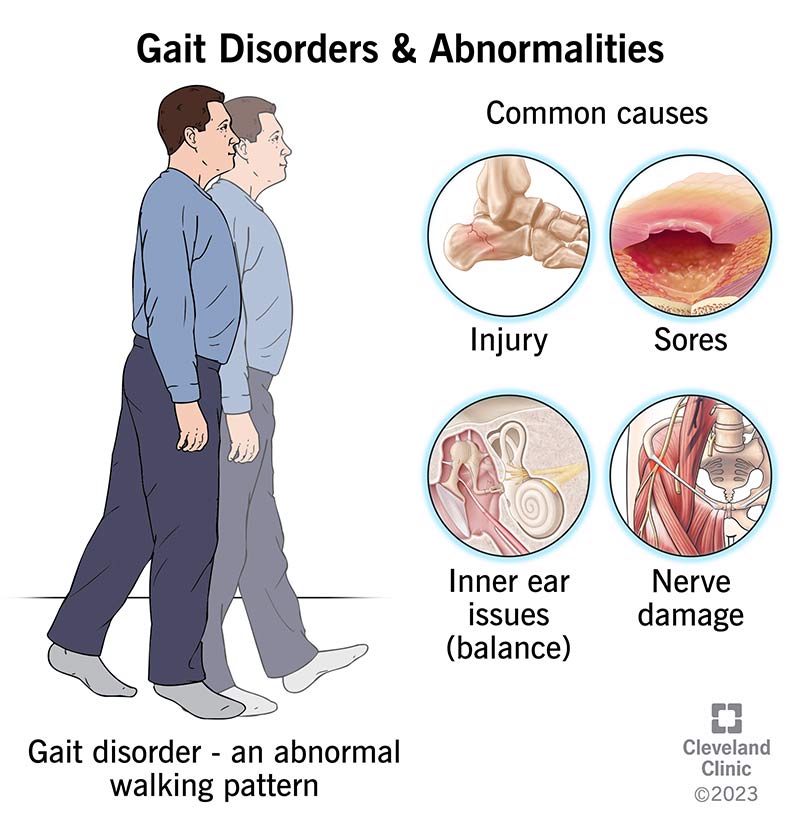Gait is the pattern that you walk. Sometimes, an injury or underlying medical condition can cause an abnormal gait. You may notice an abnormal gait if you drag your toes when you walk, take high steps or feel off balance when walking. Certain gait abnormalities are temporary and others require lifelong management.
Advertisement
Cleveland Clinic is a non-profit academic medical center. Advertising on our site helps support our mission. We do not endorse non-Cleveland Clinic products or services. Policy
A gait is your pattern of walking. When you walk, your muscles balance and coordinate your movement.
Advertisement
Cleveland Clinic is a non-profit academic medical center. Advertising on our site helps support our mission. We do not endorse non-Cleveland Clinic products or services. Policy
An abnormal gait is a change to your walking pattern. Everyone’s natural walking style is unique. However, injuries and medical conditions can affect your walking pattern. Anything that affects your brain, spinal cord, legs or feet can change your gait. Some common examples of an abnormal gait include:
Another term for an abnormal gait is ambulatory dysfunction.
There are several different types of gait abnormalities, the most common include:
Advertisement
Other types of gait abnormalities include:
Gait abnormalities are more common as you age. Around 15% of people experience a gait abnormality by age 60. However, more than 80% of people over age 85 have a gait abnormality. Children are less likely to have a gait abnormality unless they have an underlying health condition or experience an injury.

Signs and symptoms of gait abnormalities vary based on which type of abnormality you’re experiencing. Some of the most common symptoms include:
There are a lot of possible causes of and contributing factors to gait disorders or abnormalities. The most common causes include:
Underlying health conditions that can cause gait abnormalities include, but aren’t limited to, the following:
Some abnormal gaits have more than one cause.
You may be more at risk of developing gait abnormalities if you:
The complications of gait abnormalities could include:
Advertisement
A healthcare provider will diagnose gait abnormalities during a physical exam. They’ll take a complete medical history, as well as:
A healthcare provider may run different types of tests to learn more about the type of gait abnormality you have and what’s causing it. Imaging tests like an X-ray and laboratory tests may be necessary.
Treatment for gait abnormalities varies based on the type of gait and its cause. Treatment options could include:
If you have an abnormal gait, your healthcare provider will give you instructions to prevent falls and injuries.
Advertisement
Talk to your healthcare provider about the side effects of treatment before you begin. You may experience pain, swelling or scarring after surgery. You might also experience side effects that vary based on the medication that your provider prescribes.
Some gait abnormalities are temporary and go away when your body heals, especially after an injury. Others can be lifelong and need continued maintenance.
The most important part of your outlook focuses on preventing falls. Injuries are common if you have an abnormal gait. Your healthcare provider will give you guidance on how you can reduce your risk of injury if you have a gait abnormality.
Many people find assisted mobility devices, like a cane or walker, helpful. These devices improve your ability to navigate independently. They can also improve your confidence if you’re unsteady on your feet without support. If you have trouble completing your daily tasks due to a condition that affects your mobility, talk to a healthcare provider, occupational therapist or care team about resources that can help you at home.
You can’t prevent gait abnormalities caused by an underlying medical condition. You can reduce your risk of injury by:
Advertisement
Visit a healthcare provider if you:
Visit the emergency room or call 911 (or your local emergency services number) if you experience an injury that causes severe pain or swelling or you’re unable to get up or move. Contact emergency services immediately if you experience a fall or another trauma.
Gait abnormalities are common and increase as you age. Some gait abnormalities are the result of an underlying health condition that may go away or lessen with treatment. Others may require lifelong care. If you have a gait abnormality, you may be at an increased risk of injury and falling. Take steps to protect yourself and reach out to a healthcare provider for guidance.
Parkinson’s disease, essential tremor and dystonia are common movement disorders. And Cleveland Clinic has the expert care and support you need to manage them.

Last reviewed on 02/22/2023.
Learn more about the Health Library and our editorial process.